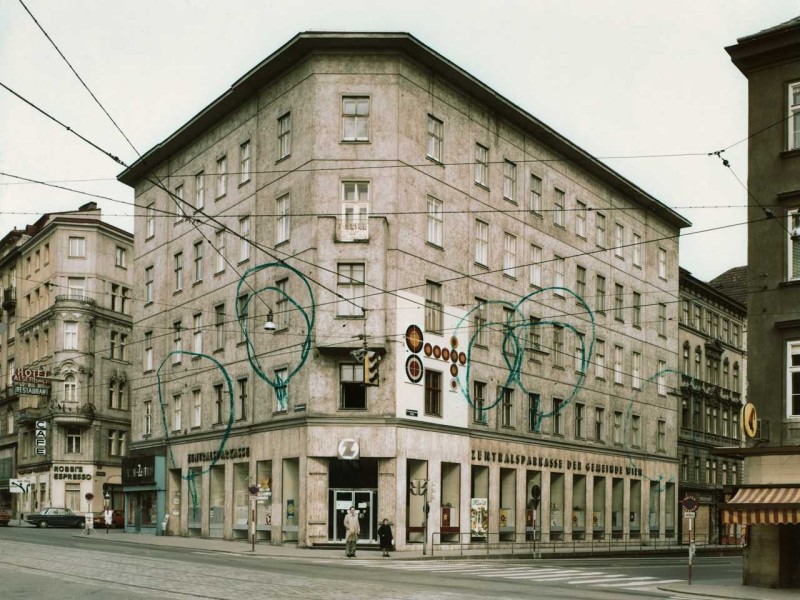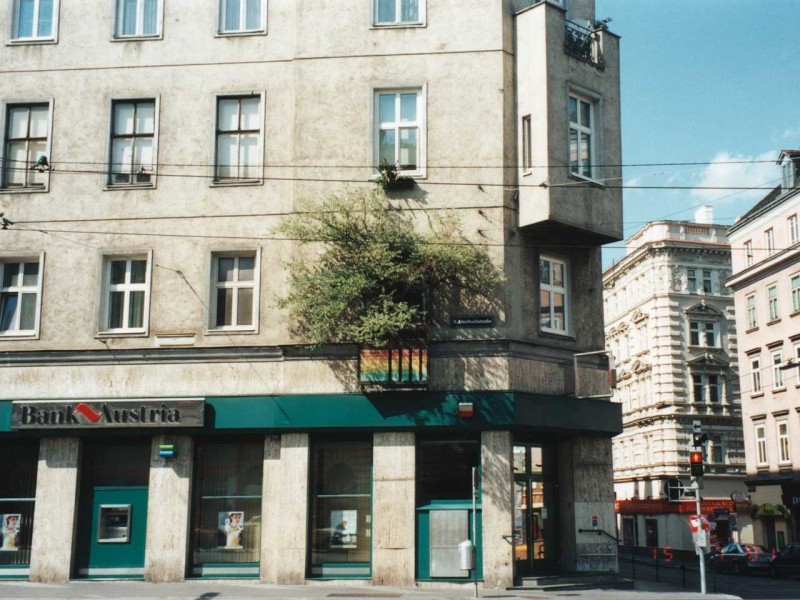ARCH 27
TREE TENANT INITIATIVE, ALSERBACHSTRASSE
Installation of a tree tenant in a branch of "Zentralsparkasse" bank
Drawing on a photo
Letter to the residents dated June 12, 1981
Vienna, 1981
Alserbachstraße 11, 1090 Vienna, A
With his tree-tenant initiatives throughout the world, Hundertwasser contributed to bringing more nature into the city and to an architecture which is more fitting to man and nature. The tree-tenant is an essential element of all his architecture projects that have been realised.
mehr weniger- Das Hundertwasser Haus, Vienna 1985, pp. 116 - 118
- Hundertwasser Architektur, Cologne, 1996, pp. 82 -84 (and c) and ed. 2006, pp. 64-66 (and c), 303 (c), 311
- A. C. Fürst, Hundertwasser 1928-2000, Catalogue Raisonné, Cologne, 2002, Vol. II, pp. 1207-1209 (and c)
- Briefmarkenbuch, Hundertwasser in Wien, Vienna, 2011, p. 17 (c)
- Regentag-Wassergläser für das Leben, Vienna, 2011, p. 79 (c, German and English edition)
- Artcurial, Paris, 1982, p. 64 (b)
- World Travelling Museum Exhibition:
- Barbican Art Gallery, London, 1983, p. 542 (b)
- HW-Die Kunst des grünen Weges, KunstHausWien, Vienna, 2011, pp. 161 (c), 215 and Front end-papers (b)
- Blaue Blume - Deutsch als Fremdsprache, Ismanig, 2002, p. 329 (b)
- Bunte, no. 33, Aug. 6, 1981, Offenburg, p. 10 (b)
- architektur aktuell, no. 9, 1981, p. 23 (b)


Hundertwasser's comment on the work
As the street is largely ruled out for planting trees due to the traffic and subterranean conduits, roof greenery mostly takes on a penthouse nature and remains invisible to the man on the street and is often unfeasible for constructional reasons, the vertical building façades are an alternative for establishing a forest in the city.
Here are just some of the advantages:
1. Tree tenants, trees growing out of the windows, are visible from afar and benefit many people.
2. Tree tenants produce oxygen.
3. Tree tenants improve the urban and residential climate considerably by mitigating the humid-dry and warm-cold contrasts. Fewer headaches - more well-being.
4. Tree tenants are a perfect dust-absorbing and dust-filtering system. In particular, the fine, toxic dust which even vacuum cleaners cannot suck up is largely neutralised and removed in the area of tree tenants. The housewife will have less dust in her apartment.
5. Street noise is significantly reduced, as the echo effect of the vertical canyons of buildings is muffled.
6. Tree tenants form a partial screen and produce a sense of security.
7. Since the tree tenants must make do with a few cubic metres of earth, they cannot develop into big trees. Their capacity for furnishing shade will thus remain very limited. So sun and light easily reach the windows the tree tenants are growing out of, too, particularly in the winter, when the leaves have fallen.
8. No trouble from spiders and ants, as they do not live in trees. But hopefully butterflies and birds will come.
9. In this way beauty and a living source of joy will be restored in a co-existence with a piece of nature in one's own house.
(excerpt from: To the Occupants of a Building on Alserbachstrasse in Vienna, 1980, translation from: Hundertwasser Architecture, Cologne, 1997, p. 82)